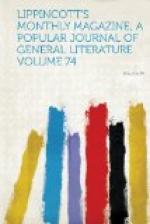From this somewhat rambling sketch the reader will readily understand that Nice is one of the great centres of society in Europe, and indeed in late years it is rather, as a place of gay reunion that it is frequented than as a resort for invalids. Since the foundation of quieter colonies at Mentone and San Remo, Nice has somewhat lost its reputation as a sanitarium, for it is rather difficult, especially for young people, to resist the temptation of its innumerable balls and round of gayeties; and these are not considered conducive to the preservation of health even amongst the healthiest. The medical men, therefore, recommend places along the neighboring coast which enjoy the same or even greater advantages of climate. That of Nice, after all that has been written about it, still seems to me one of the finest in the world. The air is exquisitely pure and clear, and has proved beneficial in many hundreds of cases of incipient consumption. But the fatal error is often made of sending hither patients in whom the disease has made considerable progress. In such cases the irritating air hastens death. I have known people brought here in the second and last stages of consumption, who have been carried off in a fortnight after their arrival, and who might have lingered on for years elsewhere. The patient who finds himself benefited should remain at Nice for at least three or four years, only varying the air in summer by a visit to some of the many pleasant places in the neighboring mountains, where the atmosphere is pure, cool and wholesome. Perhaps, it is owing in part to the brightness of the sunshine and the beauty of the scenery that soon after his arrival the health of the invalid often revives as if by enchantment. Alphonse Karr, a resident of many years, who knows every nook and corner of the place, and who has cultivated a garden in its environs as celebrated throughout the world as his own sparkling pen, says well: “Who is there so downhearted as to resist the glorious heat of the sun, the beauty of that deepest of blue seas, the loveliness of the varied trees, the tropical vegetation, the scent of the orange-flowers, the music of the brooks, the sight of the ever-changing hues of the mountains of Nizza la bella?”
R. DAVEY.
THE RASKOL, AND SECTS IN RUSSIA.
FROM THE FRENCH OF ANATOLE LEROY-BEAULIEU.
I.—ORIGIN OF THE RASKOL.
For more than two centuries Russian orthodoxy has been undermined by obscure sects, unknown to foreigners, and little known to Russians themselves. Beneath the imposing pile of the official Church have been hollowed out vast underground burrows and a labyrinth of gloomy crypts, which form a retreat for the popular beliefs and superstitions. We propose to descend into these catacombs of ignorance and fanaticism. We shall attempt to map them out, to explore their remotest nooks, and to lay hold in this, their hiding-place, of the character and aspirations of the people. Nothing could yield better means of acquaintance with the genius of the nation and the groundwork of Russian society. The Raskol, with its thousand sects, is perhaps the most original feature of Russia, and what most sharply distinguishes it from Western Europe.




